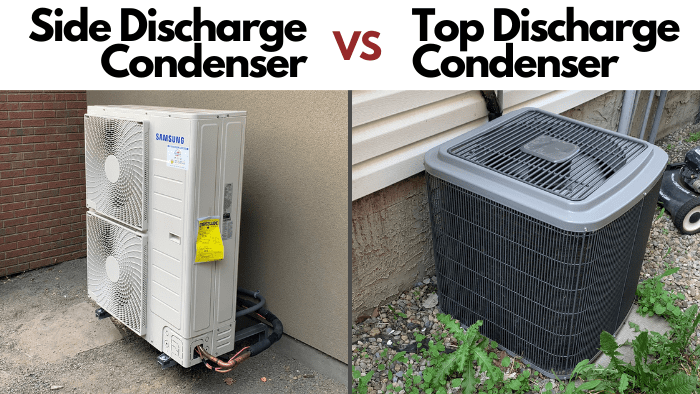Same Day Service
Since 2001
is the season, to start turning on your air conditioning! That is if you are lucky enough to have A/C in your home.
In Alberta, we often say it’s not worth it because of the number of days you need it. (If you have joined the home A/C club, you can testify that it is worth the investment!)
If you are thinking “This is the year!” or if you have already joined the A/C club…read on to understand how A/C works in a home.

An A/C unit is made up of a condenser and an air conditioning coil.
The condenser is the unit that is outside the home. The condenser unit has a condenser fan, a capacitor, and coil lines.
This is an example of a condenser you will see outside a person’s home.

The looping coil lines connect from the condenser to the A-coil inside the unit. The looping coil lines hold a refrigerant. When the refrigerant gas is compressed, its pressure rises, making it very hot. The hot refrigerant gas moves through a series of coils, which has a cooling effect, lowering its heat and then it’s converted to liquid. The refrigerant liquid then flows through an expansion valve, which causes it to cool down until it evaporates.
The air pushes the refrigerant through the condenser coils and the compressor, then eventually to the A-coil or air conditioning coil. The A-coil is very cold and sits on top of the furnace. The fan of the furnace pushes air through the A-coil, cooling the air as it passes through.
This is an example of an A-Coil that sits in a box on the top of the furnace. It is like a very cold fridge that a fan will blow air through.

The cold coil lines of the A-coil cause a cooling effect. Air that is blown up by the furnace fan through the A-coil. There air passes through the vents and duct work, (just as it does when the furnace is blowing warm air through to heat the home).
Once the refrigerant has spent its cold air it returns to the compressor. Once the refrigerant is compressed the process starts again. As the compressed refrigerant expands it creates a cool effect and again moves towards the A-coil.
The cold coil lines of the A-coil cause a cooling effect. Air that is blown up by the furnace fan through the A-coil. There air passes through the vents and duct work, (just as it does when the furnace is blowing warm air through to heat the home).
Once the refrigerant has spent its cold air it returns to the compressor. Once the refrigerant is compressed the process starts again. As the compressed refrigerant expands it creates a cool effect and again moves towards the A-coil.
Condenser coils need to be cleaned every year!
Cleaning your A/C coils will increase the life of your furnace. Cleaning your condenser coils will reduce the amount of energy your A/C unit consumes.
Just like any fan, the condenser unit will suck in air, and leave dust and debris on the outside.
Compressor “fins” are located in the condenser, (the outside portion of your A/C unit). Look for a metal grate that has metal fins.
THE FINS ARE FRAGILE. Be careful.
The fins are part of the condenser that helps move heat away from the air conditioner so the refrigerant cools more quickly.
Cleaning the fins and screens of the condenser is a part of maintenance!
This is an example of an extremely dirty condenser that won’t let air flow through.

Each year your A/C unit needs to be cleaned and serviced. Our technicians can provide this service, book a service call if you need our help.
Here are some directions on how to clean your outside air conditioning unit.

3. Use a shop vac to clean leaves and debris caught inside.
Be very careful not to damage the metal fins inside the unit.
4. Next, use a spray foam coil cleaner to clean the fins inside the unit. Let the foam sit for at least 10 minutes. Do not use brushes or cloths as the delicate metal fins will bend and become a permanent air block.

5. It is best to wash from the inside out, so the mud and debris are not sitting on the inside components of your compressor. Use a garden hose, with low pressure to spray from the inside out. Do Not Use A Pressure Washer, it could damage the delicate fins!

6. Use a flashlight to see how well the light shines through, to ensure unseen dirt is gone.

7. Once cleaned, carefully put the top with the fan back and secure it.
8.Turn the power to your A/C unit back on.
There are lots of issues with A/C, but most issues result from restricted airflow.
If the air conditioner coming on, but the air is not cold, you may be experiencing a blockage in air flow somewhere.
Restricted airflow somewhere in the Air Conditioner system may not allow the refrigerant to get cold.
When the outside part of the air conditioner, the condenser, is dirty it will impact the performance of the air conditioner. Consequently, it needs to be cleaned every year.
Another area that could have restricted airflow is the A-coil, inside the home.
This is an example of a dirty A-Coil.

Another issue could be that the A/C unit comes on, but nothing is blowing. There may be an issue with the airflow from the furnace.
Below are examples of frozen air conditioner units with poor airflow, or sized too large.

What do you do if your home A/C is leaky?
If the refrigerant leaks out of your condenser, your A/C unit will need a repair, and possibly a replacement. (Often the A-coil will need to be replaced.)
Signs that the refrigerant is leaky are ice on the coils. You will see freezing from the inside A-coil to the outside components of the compressor.
One of the most critical components of an air conditioning unit is the capacitor. It is housed inside the condenser, the outside part of the a/c unit.

The capacitor is the jump-start for the a/c system.
The coolant is under tremendous pressure. It needs a big electrical boost to get moving through the condenser. The capacitor provides a charged kickstart for the condenser to work, as well as a smaller jolt for the fan to start spinning.
The capacitor can burn out or not provide enough electricity to start the condenser fan.
A technician can test this component and see if it is operating the unit within acceptable bounds.
